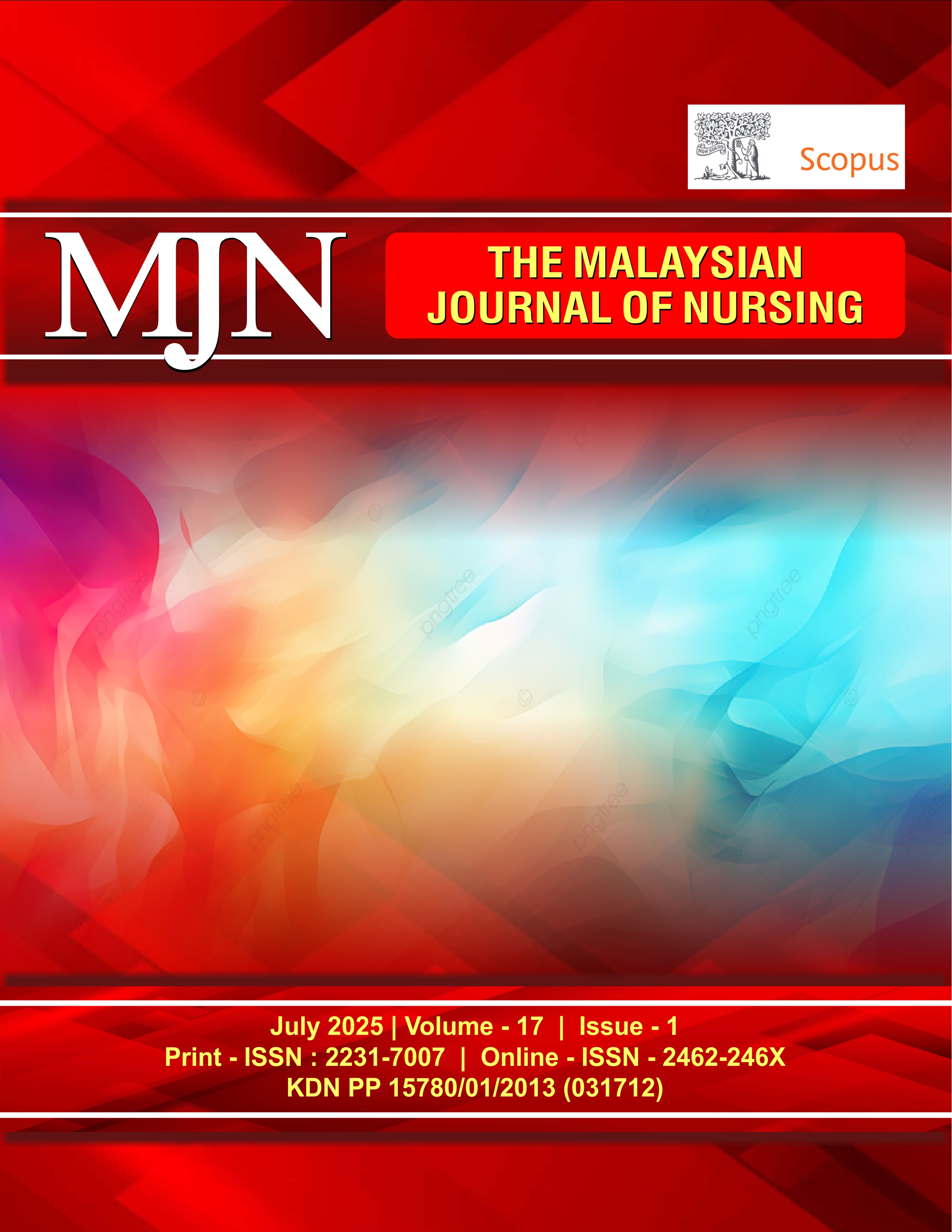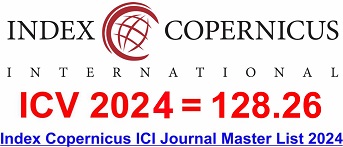Contraceptive Knowledge and Attitude of Sabah Married Women
DOI:
https://doi.org/10.31674/mjn.2025.v17i01.020Abstract
Background: An unplanned pregnancy was identified as a major public health concern worldwide in developed and developing countries. Since nurses are frontline healthcare providers of reproductive health counselling in Malaysia, the present study evaluated the level of knowledge and attitude toward contraception among married women in Sabah, Malaysia. Methods: A cross-sectional study was conducted among 254 women who resided in the Interior and West Coast Division of Sabah, Malaysia. Knowledge and attitude on the contraceptive questionnaire were administered to participants via convenience sampling. The instruments had high level of reliability, with a Cronbach’s alpha coefficient of 0.73 for both knowledge and attitude. Results: The participants’ mean age was 35.20 ±7.189 years. Most respondents (n=92, 36.2%) had poor knowledge of contraceptives, while (n=162, 63.8%) showed a satisfactory attitude towards contraception. Age group, residential address, monthly income, and number of children were significantly associated with women’s knowledge level (p>0.05). Meanwhile, the monthly income and number of children were significantly associated with attitude level of women residing in Sabah (p<0.05). Conclusion: A worryingly high percentage of women in Sabah demonstrated poor knowledge, despite showing a satisfactory attitude. This crucial information can guide targeted interventions to improve contraceptive awareness and uptake. Community health nurse and nurse-midwives can leverage these findings to design targeted, culturally sensitive education and counselling interventions, particularly for lower-income, multiparous, and rural women, to improve contraceptive literacy and uptake.
Keywords:
Attitude, Contraceptive, Knowledge, WomenDownloads
References
Alina, T.I., Norbanee, T.H., Hashim, M.H., & Zaki, N.M. (2006). Knowledge on family planning among Malay women who delivered at Hospital Universiti Sains Malaysia (HUSM), Kelantan and their Husbands. Malaysian Journal of Public Health Medicine, 6(2), 68-71. Retrieved from: https://www.mjphm.org.my/mjphm/journals/Volume%206%20(2)%20:%202006/68-71.pdf . Accessed on 15th July 2023.
Alkalash, S. H., Alessi, S. M., Alrizqi, A. A., Alamri, A. A., Al Kenani, A., Alrizqi, H. A., & Alqozi, R. (2023). Knowledge on, attitude toward, and practice of contraceptive methods among females of reproductive age in Al-Qunfudah Governorate, Saudi Arabia. Cureus, 15(3). https://doi.org/10.7759/cureus.36606
Askew,I., Raney, L., Kerrigan, M., & Sridhar, A. (2023). Family planning saves maternal and newborn lives: Why universal access to contraception must be prioritized in national maternal and newborn health policies, financing, and programs. International Journal of Gynecology & Obstetrics, 164, 536–540. https://doi.org/10.1002/ijgo.15127
Beyene, S. A., Garoma, S., & Belachew, T. (2025). Prevalence and predictors of modern contraceptive method utilization among married couples in the pastoralist communities of Fentale district, Eastern Ethiopia. Scientific Reports, 15(1). https://doi.org/10.1038/s41598-025-92285-1
Binti Salim, S. (2022). Understanding unmet family planning needs and unplanned pregnancies in Malaysian women. International Journal of Science and Research Archive, 13(02), 447–454. https://doi.org/10.30574/ijsra.2024.13.2.2154
Binu, K. M., George, D., Francis, G., Praveena Ponnachan, Thomas, S., & Doddayya, H. (2021). Knowledge, attitude, and practice towards family planning among married women of reproductive age group – A hospital-based study. Manipal Journal of Pharmaceutical Sciences, 7(1). Retrieved from: https://impressions.manipal.edu/mjps/vol7/iss1/7 . Accessed on 20th May 2023.
Bradshaw, C. J., Perry, C., Judge, M. A., Saraswati, C. M., Heyworth, J., & Le Souëf, P. N. (2023). Lower infant mortality, higher household size, and more access to contraception reduce fertility in low-and middle-income nations. PloS One, 18(2). https://doi.org/10.1371/journal.pone.0280260
Connelly L. M. (2008). Pilot studies. Medsurg Nursing, 17(6), 411–412. Retrieved from: https://www.scirp.org/reference/referencespapers?referenceid=2714828 . Accessed on 12th July 2023.
Department of Statistics Malaysia (2022). Key Population Statistics by Administrative District in Sabah. Retrieved from: https://open.dosm.gov.my . Accessed on 20th May 2023.
Hassan, H., Manaf, R. A., & Ismail, S. (2019). family planning practice among married orang Asli women in Sepang district and its associated factors. Malaysian Journal of Medicine & Health Sciences, 15(SP3), 29-35. Retrieved from: https://medic.upm.edu.my/upload/dokumen/2019110412052305_MJMHS_0397.pdf. Accessed on 19th August 2023.
Kassim, M., & Ndumbaro, F. (2022). Factors affecting family planning literacy among women of childbearing age in the rural Lake zone, Tanzania. BMC Public Health, 22(1). https://doi.org/10.1186/s12889-022-13258-x
Lasimbang, H. B., Tha, N. O., Teo, J. B. H., & Amir, L. E. (2018). Knowledge, Attitude and Practice of Contraception by Doctors and Women in Kota Kinabalu, Sabah. Borneo Journal of Medical Sciences (BJMS), 12(1), 23-23. https://doi.org/10.51200/bjms.v12i1.749
Lee, K. Y., Othman, E., Hassan, H., Mohammad Yusof, F., & Yusof M. P. (2019). Knowledge, Attitude, and practice level of family planning service recipients in the health district of Petaling, Selangor. International Journal of Public Health and Clinical Services, 6(5), 9-21. https://doi.org/10.32827/ijphcs.6.5 .
Nachimuthu, H., Devi, H., & Karunanithi, N. (2022). Knowledge, awareness, and perception on contraception among women of reproductive age attending Senawang Health Clinic. Malaysian Journal of Medical Research (MJMR), 6(2), 16-27. https://doi.org/10.31674/mjmr.2022.v06i02.004
National Health and Morbidity Survey (NHMS). (2022). Maternal and Child Health, Institute for Public Health. Retrieved from: https://iku.gov.my/images/nhms-2022/TRNHMSmch2022.pdf. Accessed on 19th April 2023.
Population Reference Bureau (PRB). (2021). Abortion Facts and Figures 2021. Retrieved from: https://www.prb.org/resources/abortion-facts-and-figures-2021/. Accessed on 19th August 2023.
Roasoft. (2004, April,10). Sample Size Calculator. Retrieved from: http://www.raosoft.com/samplesize.html . Accessed on 20th August 2023.
Sheng, B., Yao, D., Zhang, H., Tang, J., & Du, X. (2024). Knowledge, attitude and practice of contraceptive methods among women with an unplanned pregnancy. BMJ Open, 14(3). Retrieved from: https://bmjopen.bmj.com/content/14/3/e078364. Accessed on 19th September 2023.
Sherpa, S. Z., Sheilini, M., & Nayak, A. (2013). Knowledge, Attitude, Practice on Preference of Contraceptive Methods in Udupi District, Karnataka. Journal of Family and Reproductive Health, 7(3), 115-120. Retrieved from: https://jfrh.tums.ac.ir/index.php/jfrh/article/view/272. Accessed on 24th July, 2023.
Von Elm, E., Altman, D. G., Egger, M., Pocock, S. J., Gøtzsche, P. C., & Vandenbroucke, J. P. (2007). The Strengthening the Reporting of Observational Studies in Epidemiology (STROBE) statement: guidelines for reporting observational studies. The Lancet, 370(9596), 1453 - 1457. https://doi.org/10.1016/S0140-6736(07)61602-X
Wan Jusoh, W. S. A., Awaluddin, S. M., Sahril, N., Hamid, N., Shamsudin, N., Abd Wahab, N., ... & Ahmad, N. A. (2025). Unmet family planning needs in Malaysia: prevalence, associated factors, and implications for targeted interventions. Contraception and Reproductive Medicine, 10(1). https://doi.org/10.1186/s40834-025-00347-6
World Health Organization (WHO). (2023). Family planning/contraception methods. Retrieved from: https://www.who.int/news-room/fact-sheets/detail/family-planning-contraception . Accessed on 4th December 2023.
Yusof, M., Samad, A. A., Omar, M., & Ahmad, N. A. (2018). Unplanned pregnancy and its associated factors. Global Journal of Health Science, 10(8), 132-142. https://doi.org/10.5539/gjhs.v10n8p132
Yusoff, R. M., Akhlak, S. M., Mohammadnezhad, M., Mat, N. H. N., & Salehan, H. M. (2022). Determinants of knowledge, attitude and practices towards family planning among women in Raub, Pahang, Malaysia. Malaysian Journal of Medicine & Health Sciences, 18(2), 123-128. Retrieved from: https://medic.upm.edu.my/upload/dokumen/2022031418425319_MJMHS_1225.pdf. Accessed on 20th March 2023.
Zelalem, D., Worku, A., Alemayehu, T., & Dessie, Y. (2021). Association of effective spousal family planning communication with couples' modern contraceptive use in Harar, Eastern Ethiopia. BMC Public Health, 12, 45–62. https://doi.org/10.2147/OAJC.S285358
Zulfakar, M. H., Islahudin, F., & Punniaseelan, N. (2023). Contraceptive awareness, knowledge and attitude among unmarried young adults in Malaysia. Malaysian Journal of Pharmacy (MJP), 9(1), 5-10. http://dx.doi.org/10.52494/RJMT2943
Published
How to Cite
Issue
Section
License
Copyright (c) 2025 The Malaysian Journal of Nursing (MJN)

This work is licensed under a Creative Commons Attribution-NonCommercial-NoDerivatives 4.0 International License.



































